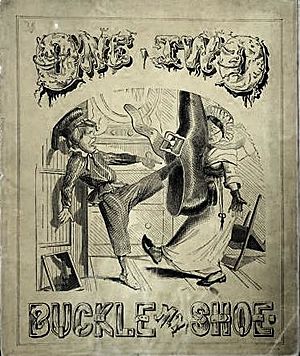One, Two, Buckle My Shoe facts for kids
Quick facts for kids "One, Two, Buckle My Shoe" |
|
|---|---|

Augustus Hoppin's illustration, published in New York, 1870
|
|
| Nursery rhyme | |
| Published | 1805 |
One, Two, Buckle My Shoe is a very old and popular English nursery rhyme. It is also a counting-out rhyme. This means it can be used to choose someone in a game. The rhyme helps children learn to count from one to twenty. It has been around for over 200 years!
Contents
The Rhyme's Words
The most common version of the rhyme can be found in The Oxford Dictionary of Nursery Rhymes. It helps kids learn numbers and simple actions.
- One, two, Buckle my shoe;
- Three, four, Knock at the door;
- Five, six, Pick up sticks;
- Seven, eight, Lay them straight:
- Nine, ten, A big fat hen;
- Eleven, twelve, Dig and delve;
- Thirteen, fourteen, Maids a-courting;
- Fifteen, sixteen, Maids in the kitchen;
- Seventeen, eighteen, Maids in waiting
- Nineteen, twenty, My plate's empty.
Sometimes, you might find slightly different words for the rhyme. This is common for old songs passed down through time.
Illustrated Books of the Rhyme
Over the years, "One, Two, Buckle My Shoe" has appeared in many children's books. These books often had beautiful pictures to go with the words.
Early Picture Books
In 1857, a book with pictures by Caroline R. Baillie was published in Edinburgh. It showed scenes from homes in the 1700s. Later, the famous artist Walter Crane created two illustrated versions in London.
The first was a picture book in 1869. Its inside covers showed pictures for the numbers 1 to 10 and 11 to 20. In 1910, Crane made another book called The Buckle My Shoe Picture Book. This one included other rhymes too. It had colorful full-page pictures for each line of the rhyme.
American Editions
In America, this rhyme was also used to teach counting. Around 1870, a New York publisher named Hurd and Houghton released a book just for this rhyme. It had funny drawings by Augustus Hoppin.
Another book, Old Mother Goose’s Rhymes And Tales, came out in 1889. It had a single page for the rhyme. The pictures were drawn by Constance Haslewood. Her style was similar to another famous children's artist, Kate Greenaway. These books helped make the rhyme even more popular.
Images for kids


